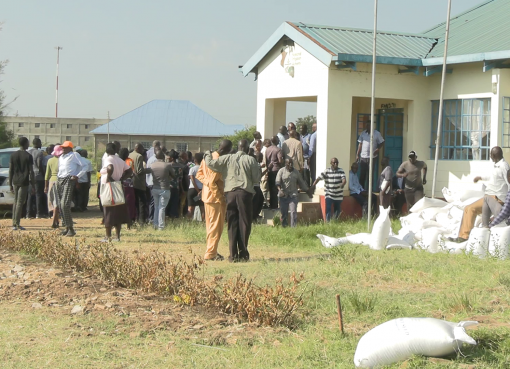Agriculture still remains the backbone of Kenya’s economy. Data from the Kenya National Bureau of Statistics shows that the agriculture sector contributes about 30 per cent of the Gross Domestic Product (GDP) and accounts for 80 per cent of National Employment, mainly in the rural areas.
The sector also contributes more than 60 per cent of the total export earnings and about 45 per cent of government revenue.
However, even with unemployment rate standing at about 40 per cent in the country, many young people do not feel the urge to engage in agriculture, but instead, look for white collar jobs which sometimes are not available.
As millions of young Kenya today are jobless, Daniel Rotich, 27, decided to make lemonade out of a bitter lemon of joblessness. He is smiling all the way to the bank after he ventured into farming.
Rotich is making approximately Sh. 200,000 a month from the sale of French beans alone.
The farmer who is originally from Bomet County came to Narok town in search of employment but after failing to secure one, he ended up being involved in farming. Through his research, he found out that there was a huge potential and a big market for French beans in the international market, especially Europe.
French beans scientifically known as Phaseolus vulgaris belong to the Fabaceae family and are bred and cultivated for their pods and seeds.
Although the crop has a low consumption rate in the country, it is one of the dominating crops in the export market.
In Kenya, they are grown mostly in warm-wet regions such as Nakuru, some parts of Kajiado, Thika, Murang’a, Machakos, Uasin Gishu, Western Kenya, Kisumu, Kirinyaga, Nyeri and Naivasha.
Rotich currently cultivates two acres of French beans in Eor –Ekule in Narok East Sub-County. He has leased each acre of land for Sh. 8,000 for a year. Rotich also plants snow- peas, onions and tomatoes in a small section of his land but he is gradually doing away with them to concentrate purely on French beans farming.
“I came to Narok County about three years ago in search of work but a friend recommended to me to find a piece of land I could lease and start farming. I took his advice and this has been my second year as a farmer,” says Rotich.
He says finding a piece of land suitable for this farming wasn’t a hard task considering there was lots of land lying idle in the outskirts of town without any form of economic activity on them.
The biggest challenge he faced, however, was the fact that farming was a new phenomenon to him and he wasn’t well informed on what French beans farming entailed.
The French bean crop thrives in well drained soils which are rich in organic matter and with a slightly acidic to alkaline PH of 6.5-7.5. The optimum growing temperature for the crop ranges from 20-25°Centigrade but it can survive in temperatures ranging between 14-32oC depending on the variety.
Extremely high temperatures result into poor flower development and pod set. The optimum altitude ranges between 1000 – 2100M is suitable for the crop, however, French beans mature faster in warmer areas.
For rain fed farming, well distributed annual rainfall of between 900-1200mm is suitable. Irrigation should, however, be done if rainfall is inadequate.
Too much rain or long dry spells are not favorable and lowers yields. Excessive rainfall during flowering causes flower abortion and increased disease incidences.
Moisture availability affects uniformity, yield and quality of the produce and therefore watering is essential in cases where rainfall is inadequate.
It is also advisable to grow the crop on ridges and use furrow irrigation in heavy clays areas because French beans are very sensitive to water logging.
Lack of water during flowering and pod formation causes flower abortion and curved pods leading to reduced yields.
Narok County being a semi-arid area, Rotich was forced to rely on irrigation. This, however, meant buying a generator, finding enough water supply and hiring a watchman who will protect his property and crops from theft and destruction by animals.
“With irrigation, French beans can be grown throughout the year. The beans take three months to be ready for harvest and right now I harvest three times a year,” he adds.
The commonly grown French beans varieties in Kenya include Samantha, Boston, Serengeti, Amy, Belcampo, Julia, Paulista, Rexas, Lomami, Hawaii, Morgan, Pekera, Picasso, Buffalo, Tokai, Teresa, Gloria, Cupvert, Seagull and Espadia, among others.
Rotich further says he has to apply Di-ammonium Phosphate (DAP) fertilizer before planting and top-dresses with Calcium Ammonium Nitrate (CAN) fertilizer twice, when the crop has three leaves and at flowering stage.
Rotich also has to weed the crop two weeks after planting and repeats after every other two weeks.
DAP is preferred because it contains considerably higher levels of phosphorus which helps the crop with root development. CAN in turn fixes nitrogen in the soil which increases the green color of the leaves, responsible to make food for the plant.
For each acre of land, Rotich harvest more than 3,000 Kilograms (kg) of French bean. The current local market price for a single kilogramme is Sh. 60 but he says prices go higher during festive seasons such as in November and December holidays. He sells a Kilogram at Sh. 100.
However, his farming isn’t without challenges, the major one being the shortage of water in Narok which forces him to spend a large portion of his income in pumping water from a nearby stream, fuel for the generator as well as costs.
He further says he lacks good and steady local market which has been forcing him to sell part of his produce to middle-men who sometimes offer low prices.
“Selling French beans in Kenya is hard because most people don’t buy. I am forced to find international market and since I don’t work for any of the companies that export the product, I have a broker who is the intermediary between me and the companies,” he adds.
Rotich says this causes him to lose some money since the companies buy at a lower price. He further adds that the prices of purchasing fertilizer and insecticides for the crop are high. This, he says, is a challenge that the government needs to look into.
He appeals to the government to support local farmers by subsidizing the prices of commodities they require for farming like seeds, fertilizer and insecticides.
The young farmer requests research to be done on farm lands so that farmers can be sensitized on types of crops they can be planting apart from the usual maize and beans and also help farmers to diversify their farming.
Rotich has learnt that one cannot mourn over a situation that find him/herself in but can make something out of it. He advises all young people to think out of the box instead of complaining over joblessness but to see what they can make out of their predicament.
“There is always a positive side to a negative situation, a silver-lining behind a dark cloud,” Rotich says.
By Mabel Keya – Shikuku and Joseph Kariuki




